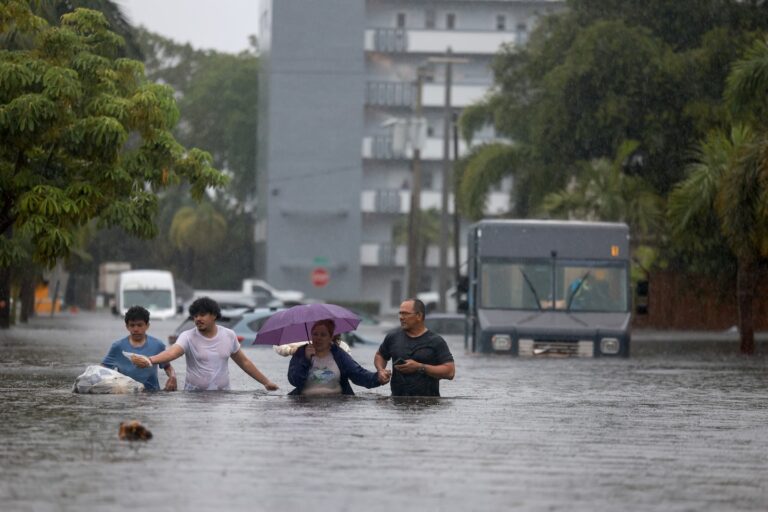The Republican governor declared a state of emergency for South Florida but during a press conference on Friday downplayed the notion that the storm was unusual, saying there have been similar events “going back decades.”
“This is obviously not unprecedented,” he said, “but I think the difference between now and 50 or 100 years ago is that we’re much more developed and the impacts of these types of events are much greater.”
The governor’s communications team also downplayed the storm, dismissing it as typical summer rain. Christina Putsch, a former press secretary to the governor and now a state analyst, wrote to X, “Welcome to rainy season. South Florida is tropical. Expect thunderstorms for the next 4-5 months.”
No deaths were reported as a result of the storm, but some areas were flooded with waist-high water and residents had to be rescued.
The uproar over how to describe the storm comes a month after Governor DeSantis signed a bill that removes most references to climate change from state law. The bill, which is set to take effect July 1, removes climate change as a priority in energy policy decisions, even though the state faces daily threats of extreme heat, deadly hurricanes, and toxic algal blooms.
Meanwhile, Florida Democrats have accused DeSantis’ team of downplaying the hurricanes at the start of hurricane season, which begins June 1 and which forecasters predict could be one of the most active on record. Democrats also pointed out that DeSantis signed a state budget this week that rejects about $205 million in stormwater, wastewater and sewer projects across the state.
“Living in Florida, what we’re seeing right now is not the same weather we’ve seen in 1,000 years,” said state Rep. Darryl Campbell, a Democrat who represents Broward County. “We see the impacts of climate change on our daily lives and we see the governor veto a bill that the Legislature unanimously passed to address it.”
A record-breaking heatwave hit the state last month. Temperatures soared to 115 degrees in Key West, making the summer of 2023 the hottest on record for several Florida cities.
Gov. DeSantis and his administration have mocked critics who say the state should do more to address climate change.
“What surprises me about the current debate about Florida weather is that the left seems to believe @GovRonDeSantis can control the rain, yet he refuses to use that authority,” DeSantis press secretary Jeremy Redfearn wrote to X.
The storm comes 14 months after another “torrential rain bomb” hit South Florida, dumping 22.5 inches of rain on Fort Lauderdale-Hollywood International Airport in a single day. Last year’s storm shut down all but emergency services at the city’s main hospital, shorted out electrical equipment at City Hall and stranded thousands of travelers.
Both the rain clouds and this week’s downpours bear the signature of human-made climate change: As the planet warms, the atmosphere is able to hold more water, which means more rainfall and more frequent extreme weather events.
When Governor DeSantis rejected storm-related projects this week, he said local governments could instead get funding from the state Department of Environmental Regulation. He also pointed to a recovery budget that includes more than $1.2 billion in projects, including $17.8 million to improve the “technical infrastructure” of the state’s new emergency operations center.
DeSantis has pledged to focus on affordable energy rather than climate change. It would ban offshore wind turbines and deregulate natural gas pipelines.
“We don’t want energy policy to be driven by climate ideology,” DeSantis said Friday. “That would mean people paying more and having less reliable energy.”

